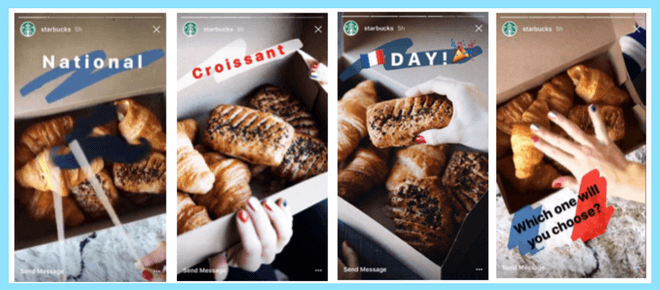Oh Snap! The social media scales have tipped again. This time around, the odds are in favor of Instagram’s ‘Stories’ feature, rolled out by Facebook in August 2016. Stories offer Instagram users a sleeker version of Snapchat, complete with a 24-hour timeline for sharing temporary “vanishing” content in addition to what’s on a user’s main feed.
The growing popularity of the update may be bad news for Snapchat die-hards, but for brands seeking an edge in the social media sphere, Instagram Stories present an invaluable opportunity to form authentic connections with one of the world’s largest customer bases (600 million people, to be exact). Intrigued? Allow us to walk you through the eight essential steps of successful Instagram Story-telling below:
1. Develop a game plan.
Identify and define specific goals in order to establish the purpose and value of Instagram Stories for your brand or business. For example, are you a destination aiming to drive visitation? A real estate company hoping to show off new listings? A nonprofit looking to raise awareness for an upcoming fundraiser? With the right marketing strategy in place, virtually any business can leverage Instagram Stories to generate authentic awareness and reach new demographics.

2. Identify your voice.
If you could name one public figure and/or celebrity who embodies your brand— who would it be? Oprah? Luke Skywalker? Will Ferrell? Believe it or not, establishing a confident answer to this question is the first step to solidifying your brand’s distinctive persona that you can then emulate through Instagram Stories.
If your designated brand mascot is Will Ferrell, for example, your posts might possess a more sarcastic, silly tone, whereas brand doppelgängers like Kate Middleton would solicit a more refined, yet playful posting style. The key is to cater your brand’s content specifically to your most desirable audience(s) to increase engagement and reel in killer client leads.
Ideally, your Instagram Stories should reflect a candid, conversational tone set apart from the more formal lingo your brand uses on other platforms. Adopting an unfiltered voice gives your brand the flexibility to showcase its dynamic business methodology using authentic scenarios, interactive visuals and real-time media that keep your followers flocking back for more.
3. Expand your reach.
Once you’ve polished your Story-telling voice, consider tagging other brands and vendors in relevant posts to connect with influencers in a variety of industries. This will help position your brand in front of people who matter.
Just like most Instagram content, Instagram Stories are now discoverable through the Explore tab, where users can find related stories from accounts they don’t yet follow. In other words, Instagram’s Explore tab is to businesses what “The Voice” is to aspiring singers: A priceless opportunity to get your brand’s voice heard and win over a loyal fan base in the process.
4. Test the waters.
Instagram Stories are like a blank canvas for your brand, and like most things in life, developing a mastery of the medium takes practice. Fortunately, Instagram makes it easy for startups, non-profits and small businesses to begin marketing their brand with little to no budget. Less monetary pressure means more freedom to experiment with different types of content.
So go ahead: whip out those junior high doodling skills and unleash the artist within! Instagram’s ever-evolving Story toolbox makes it easy to experiment with a variety of photos, video, drawings, filters, live video, boomerangs and so forth to measure and adapt to what your audience wants.
5. Stay ahead of the game.
Plan ahead for big events, product launches, local interests or upcoming holidays. Don’t be afraid to experiment with different weekly segments, trends or serialized Instagram Stories. Consider creating an easily accessible document to track real-time ideas for potential Story posts and periodically check Instagram analytics to determine what content works and what doesn’t.

Pro tip: set a strategic timeline for Story posts throughout the day to keep your Story at the top of people’s feeds. The more eyes on your content, the better!
6. Play the field.
Nowadays, research shows that consumers are just as concerned with a brand’s personality as they are with its products, placing a newfound demand on businesses to think outside the box and connect with audiences on a less promotional, more personal level in order to stay afloat in a 21st century landscape.
The main goal here is to ration content seamlessly between your Instagram Story tab and main feed to optimize a diverse amount of marketing material at once, while cementing a bond with your audience.
For businesses that fall within visually-rich industries (like real estate or tourism, for example), Instagram Stories provide the perfect stage to showcase your brand’s personality using stunning back-to-back visuals to tell your audience a story, rather than share a singular post to your main feed. For brands who want to build intimacy with their audiences aside from what’s on their main feeds, Stories let you share all those details and live moments from each day that humanize your message. Say you’re lucky enough to inhabit an office with nice window views, for instance— Why not share the view with your audience by posting a snapshot of the next sunset that rolls around?
It’s the little things that count— especially when finding common ground with the average Instagram user.

7. Earn (and retain) consumer trust.
When it comes to attracting an audience to Instagram Stories, visibility is crucial. By regularly updating Stories, brands can position their message at the top of people’s feeds, opening the door for audience engagement and reach, as long as users like what they see. According to a Sprout Social 2016 index, 41% of users won’t hesitate to unfollow brands whose posts they find undesirable or irrelevant, while 71% said they have unfollowed brands because they were embarrassed by the content or brand itself.
And that’s where content quality comes in.
8. Post with purpose.
As easily as consumer trust can be gained, it can also be lost. Always keep this in mind when crafting Instagram Stories with multiple posts per day to avoid overwhelming user’s feeds or publishing content that comes across as overly promotional or repetitive. Always stick to a cohesive storyline, weaving posts together to create a virtual novel that your audience won’t be able to put down.
In the words of digital marketing wizard Seth Godin: “Marketing is no longer about the stuff you make, but the stories you tell.”
So tell yours well.
